When I talked about my relation to Anita Sarkeesian's videos last week, I found something curious: the "Women as Background Decoration" trope that she talks about and that so infuriates gamers is especially prevalent in open-world-games. GTA, Red Dead Redemption, Kane&Lynch, Hitman, Assassin's Creed, Far Cry 3, Watch_Dogs and others popped up with alarming regularity (and yes, I know they're not all technically open-world, but they give players more freedom than your average Call of Duty). I think there's a connection between this fact and the sexist scenes that Sarkeesian dissected in her video, and it has to do with the mechanics of open-world games.
 |
| Yay, freedom for the player! |
So, where does this connection originate? I argue that it's a healthy portion of pure laziness on the designer's part. Think about what all these games have in common. You always play an outlaw or at least an outlaw-ish figure, and while you occasionally wind up on the side of the good guys (e.g. Assassin's Creed, Watch_Dogs), being an outlaw allows you to treat the police forces as an enemy and to engage in a lot of violent action. The latter one is the meat and bread of the open-world game. Let's consider what we expect of such a game.
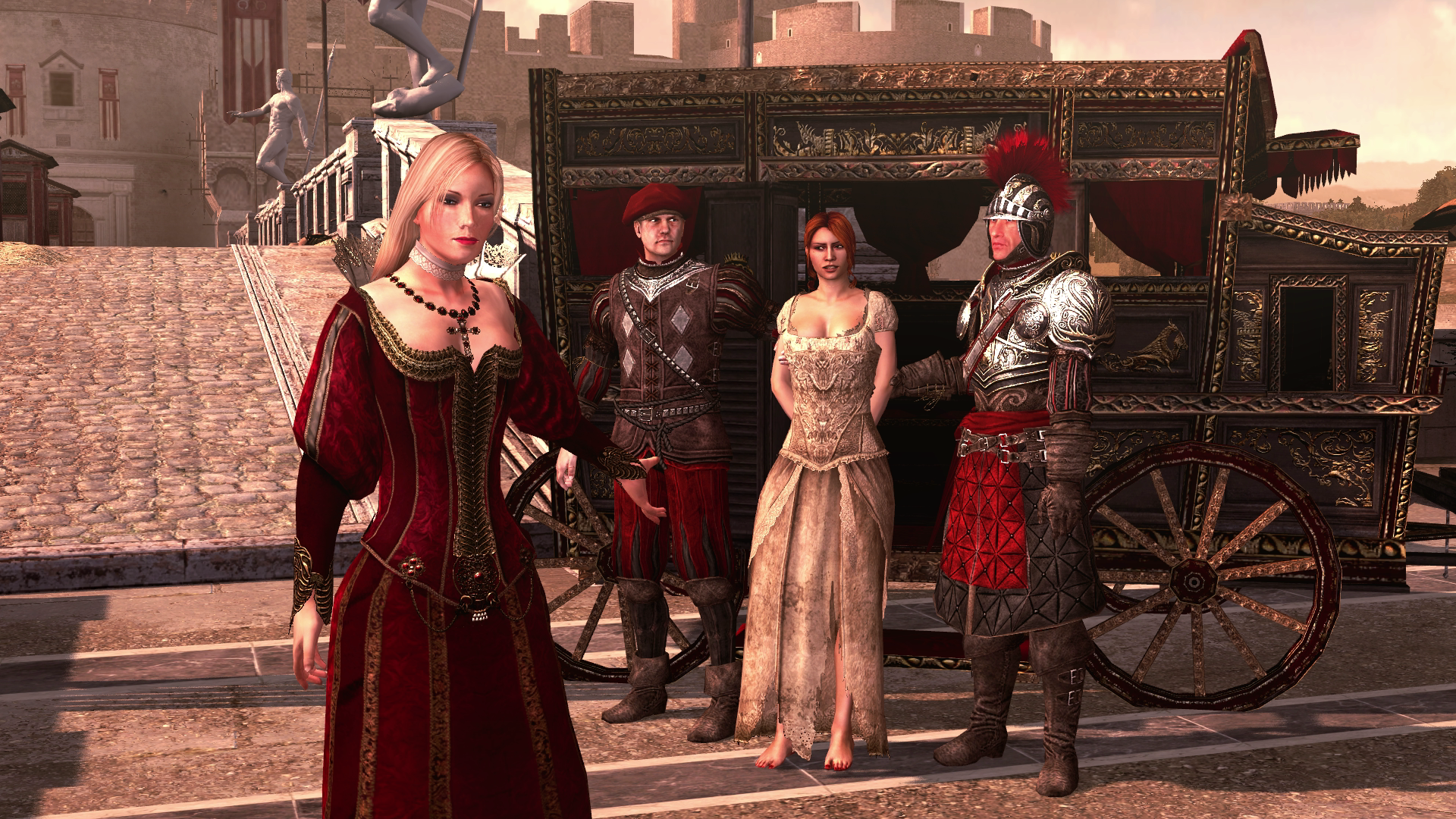 |
| Even women can treat other women as objects. Not at odds with the theory. |
You want to explore an exotic environment, complete missions and grow stronger. In some games, you may also want to progress in the main storyline, but this objective often clashes with the core gameplay of open-world-games, which is to be allowed to basically go anywhere. As I argued in my Assassin's Creed reviews, this is basically at odds with telling a larger story, and often, the balancing is entirely off as a result. But this shall not be the topic here.
 |
| Fuck you, random bread-earners. |
From the described desires and possibilities results that we need a ton of scripted events that make the world feel alive. Random acts of violence and crime often serve this role, as well as attacks by the various wild animals that populate these worlds. Your main interaction with the game world, besides moving through it, is mostly by attacking certain NPC. Usually, you are not allowed to harm "innocent" civilians, at least not without a penalty, sometimes more restricting, like in Assassin's Creed, sometimes less so, like in GTA. Instead, the game needs to give you meaningful targets at which to direct your violence, as established often the only option to interact with the world.
 |
| So many options! |
Dispensing violence, however, requires enemies. Hence, as Anita Sarkeesian argues, the violence vs. women comes in as an easy moral divide, because the main characters (mostly) don't harm women, but instead thrive to protect them. The evildoers you fight are overwhelmingly male, and the easiest way to mark them as "bad" is by letting them harm women (or by labeling them as terrorists, but that's more Call of Duty's approach and already wearing off). It would also serve the job by letting them violate children, but that seems to be a line that game designers are not (yet) willing to cross.
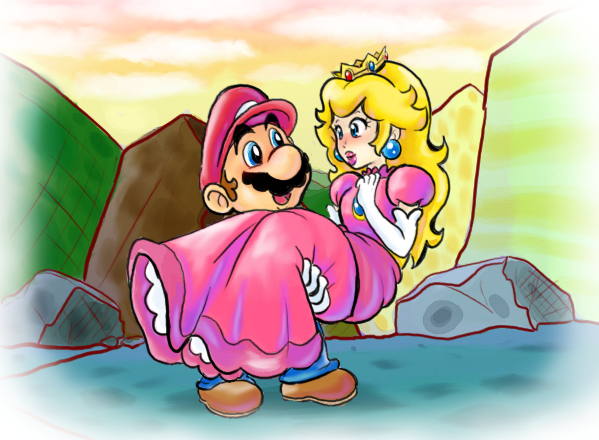 |
| Not always as benign as Dowser. |
Since in the many, many scripted sidequests, you can't spend much time with characterization, because the damn things have to be assessed in a span of one or two seconds and repeat themselves constantly, the temptation for designers to rely on this kind of motivation. Since games that are not open-world don't rely so much on randomly generated and repeatable missions, they can usually dedicate more time to these instances in the story and implement violence vs. innocents in a more meaningful way. That they often don't is, again, testament to a deep-sitting problem of games, but in theory, they have the option.
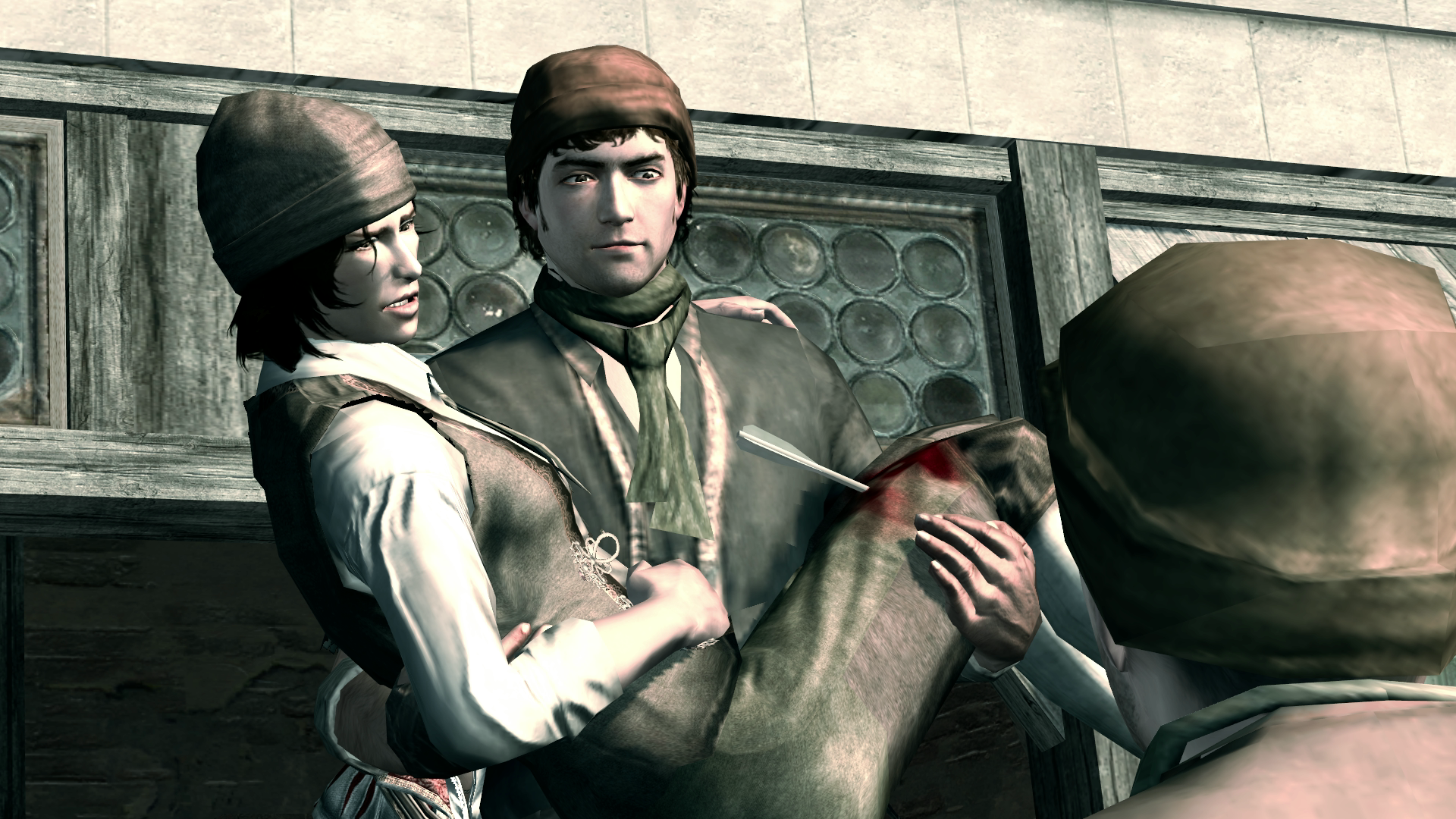 |
| One of the better examples, but still needing rescue by a man. |
This option is not present in open-world games. It is often bemoaned that these games open a divide between the main storyline and the gameplay, and this divide is also affecting the portrayal of women in its worldbuilding. Take Assassin's Creed, for example: Altair and Ezio are very determined to give their victims an honorable treatment, hearing their last words and closing their eyes. Nothing of the sort is awarded to the literally hundreds of guards you as player kill on your way to these victims, opening a stark divide between the theory in the main storyline and the reality of actual gameplay. The same is true in GTA: the main story may require you to be careful of the police, but in the gameplay proper, even mass chases and massacres aren't really a problem.
 |
| Nothing time couldn't heal. |
The gameplay itself is therefore unable to transport advanced storytelling and often even directly at odds with it. Violence, however, can only be implemented in a meaningful way if you carefully and deliberately do so, outlining the motivations and consequences of each act. In one of Sarkeesian's most impressive examples from the game Watch_Dogs, the player gets a constantly repeating sidemission in which he has to prevent domestic violence from playing out. If he fails to do so, the man murders the woman. The mission can still be brought to a succesful end by killing the perpetrator, but there is literally no thought spent on the woman. As soon as the male kills her, she becomes a background object with which you are entirely unable to interact. Tellingly, you also can't interact with the male in other way than killing him.
| Not solving problems. |
The game, being a violence-centered open-world-game, doesn't allow you any meaningful interaction to save the woman or bring the man to reason. You can only kill the guy and maybe prevent him from killing her. You can't call the ambulance or the police, give first aid or hear her dying words, because she has none. She's literally only background decoration, giving you an excuse to kill somebody. Now, this is also true for a plethora of male roles in the game, but the main difference is that men are active as well as passive, whereas women in these games are only passive victims, therefore reinforcing negative stereotypes about them.
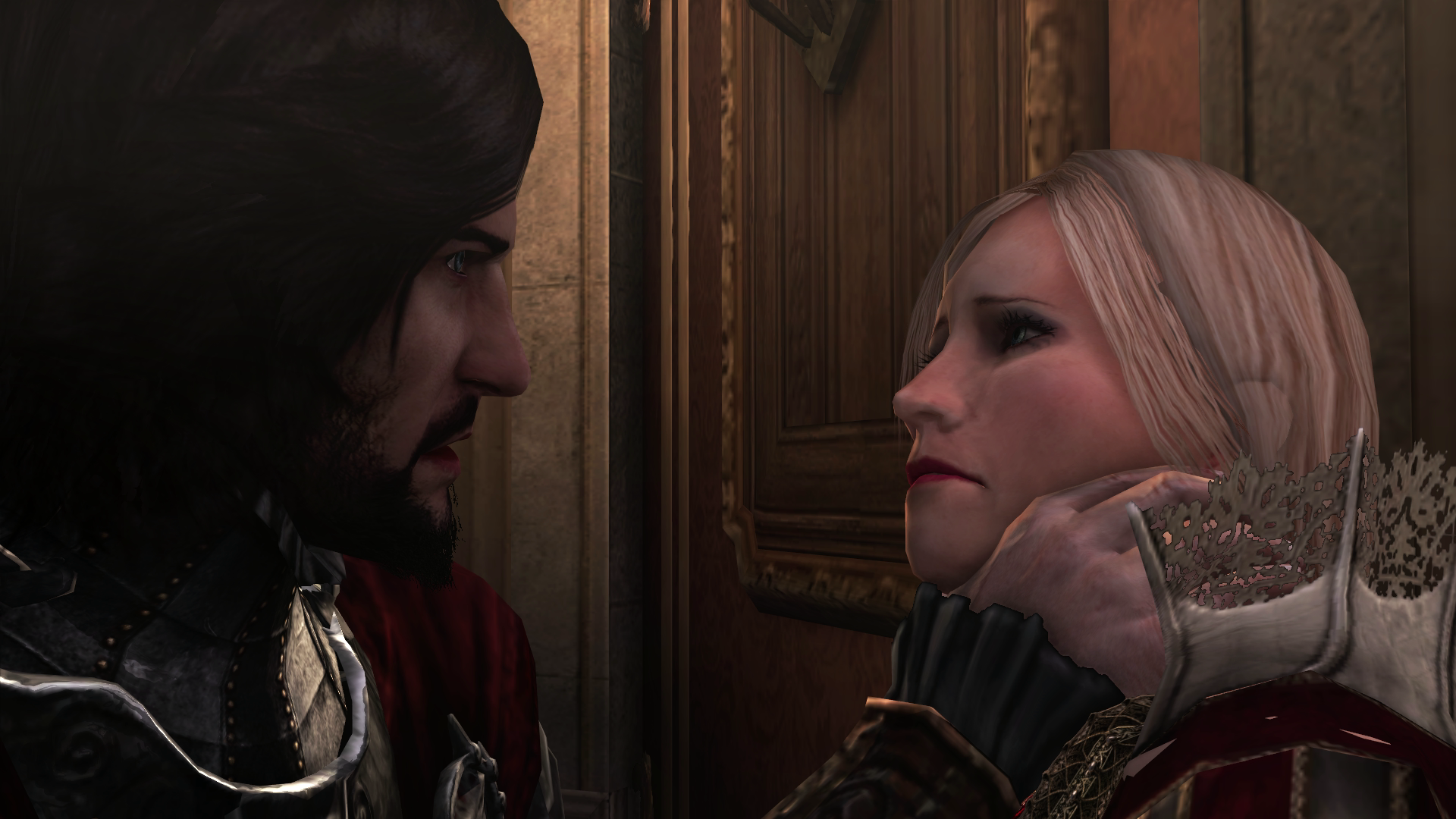 |
| Main storylines are different. Sometimes only at second glance. |
There don't exist similar stereotypes about male victims. Usually, they are expected to suffer manly through outbursts of violence or to fight back, which is a trope that provides its own host of problems, but women in open-world-games are very often reduced to the role of background decoration victims, showing how bad the people really calling the shots are. Men, on the other hand, are much more often in the role of the actor than the victim, and at least, they can fight back, a privilege women aren't awarded. The pixelated soldiers of Call of Duty, the guards of Assassin's Creed, the gangsters from Watch_Dogs, GTA and others, they are all masters of their own destiny. The women, on the other hand, are not.
 |
| Pictured: well developed characters |
Therefore, the problem of women being present as meaningless (because endlessly repeatable) background decoration is fundamentaly one of lazy choices. The only way open-world-games make the slightest bit of sense is when you're playing an outlaw, because only then is violence as the main means of interaction usable. And the latter, inherent to many open-world-games, needs to give you excuses to kill the bad guys so you're not playing a total psychopath. And the best way to do this is by reflecting sexist gender stereotypes of strong men protecting helpless women from evil men.
UPDATE
What now does this mean for the future? Scenes like the one in Watch_Dogs criticized by Sarkessian point to the aforementioned laziness in storywriting. Game designers use these scenes because they are so effective, creating a clear divide between good and evil, and allowing the player to come down firmly on the side of the good because while he is using often excessive violence, he is always killing people that are worse than he is. Of course, designing open world games that don't use these tropes means amping up the effort needed to create them considerably which, given the budgets involved already, may simply be unsustainable. In this case, however, we should really pose the question whether it's desirable to be able to explore large areas essentially full of the same repeating scenes, or whether or not a more sophisticated approach would be called for.
Simply bloating games seems to be the new standard for AAA titles, much like blowing up entire cities has become a staple for Hollywood blockbusters. The games themselves, however, don't profit from this. Thousands of repetitive sidequests only engage the most dedicated of players, and in a world where the events are basically drawn from a pool of ulimately few choices, there's not that much to explore. If designers would comit to reducing the pure spectacle in favor of some substance, the problem might be avoided, because more meaningful encounters could be written for specific portions of the game world. However, it seems like we're destined to get more of the cheap storytelling because the budget is blown away in ever more sophisticated ways to shoot the evil guys.
UPDATE
What now does this mean for the future? Scenes like the one in Watch_Dogs criticized by Sarkessian point to the aforementioned laziness in storywriting. Game designers use these scenes because they are so effective, creating a clear divide between good and evil, and allowing the player to come down firmly on the side of the good because while he is using often excessive violence, he is always killing people that are worse than he is. Of course, designing open world games that don't use these tropes means amping up the effort needed to create them considerably which, given the budgets involved already, may simply be unsustainable. In this case, however, we should really pose the question whether it's desirable to be able to explore large areas essentially full of the same repeating scenes, or whether or not a more sophisticated approach would be called for.
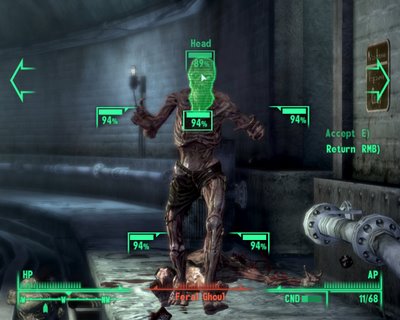 |
| This approach obscures what's important. |
Simply bloating games seems to be the new standard for AAA titles, much like blowing up entire cities has become a staple for Hollywood blockbusters. The games themselves, however, don't profit from this. Thousands of repetitive sidequests only engage the most dedicated of players, and in a world where the events are basically drawn from a pool of ulimately few choices, there's not that much to explore. If designers would comit to reducing the pure spectacle in favor of some substance, the problem might be avoided, because more meaningful encounters could be written for specific portions of the game world. However, it seems like we're destined to get more of the cheap storytelling because the budget is blown away in ever more sophisticated ways to shoot the evil guys.
I'm a little confused. To stay in your Watch_Dogs example (full disclosure: I haven't played the game): Is the laziness you are referring to the design of the domestic violence missions itself or the usage of the savior of helpless women trope? Would the mission type be acceptable in your view if it would include more immersion, like the possibility to call an ambulance or to talk with the victim?
ReplyDeleteYeah, the article is poorly structured. It's mainly a complement to Sarkeesian's videos. My point is that the inherent laziness in using stereotypes such as domestic violence that portray women as victims are inherent to open world games because of the mechanisms I described.
DeleteTo comment on open world RPG and not mention the best open world RPG of all times (Skyrim) is biased writing.
ReplyDeleteMaybe because the things that are mentioned in the article do not happen in Skyrim: plenty of strong women in there, including (optional) the main character and (always) the first follower (helper) most players usually have (Lydia), as well as many others powerfull followers (Mjoll, Alea, Ilia, Aranea Ienith, etc) and people on power (like several Jarls or advisers) and several teachers/trainers. Two of the best blacksmiths in the game are women. One of the two contenders in the Civil War for ruler of Skyrim is a woman.The head of the Dark Brotherhood (assasins guild) is a woman. The person who directs your advance through a part of the main quest is a woman (Delphine) who is clearly a bad ass and will help you take on a dragon and a camp full of bandits as part of the main quest, etc.
The explanation for the omission is easy: I never played Skyrim and it didn't pop up in any discussion of these issues, so I couldn't comment on whether or not it was better or not. Thanks for the info!
ReplyDeleteAfter rereading my comment it sound a little too harsh, sorry. It's just that in the post you try to show two things: 1) that the misogyny on open world games is due to laziness of the programers and 2) that the misogyny on open world games is inherent to the fact that they are open world.
DeleteI agree with 1), but Skyrim (which is hugely sucesfull) shows that it can be done otherwise, so I don't agree with 2). Mass Effect and Fallout also provide good interesting female characters (including the protagonist if you choose so).
I absolutely agree that this a laziness problem. That's the whole point: it's easy to do it like this, which is why many games take into it, if only sporadically (Mass Effect).
DeleteSports fever is always on it's peak when anyone talk about open games i always wanted to go there and watch them live but haven't done till the date you can also check Top 10 Best Open World Games if you are sports lover you will love it for sure
ReplyDeleteU svojoj ulozi radim s odjelima za osiguranje, obradu, financiranje i drugim odjelima. Svaki od ovih timova dolazi s ogromnim bogatstvom znanja. To mi omogućuje da steknem više znanja o svojoj ulozi i pružim članovima bolje iskustvo. Dobijte svoju financijsku slobodu od nas danas. Dugujete li, trebate zajam, brz i pouzdan, ovo je mjesto za dobivanje vjerodostojnih zajmova. Nudimo poslovne zajmove, studentske zajmove, stambene zajmove, osobne zajmove itd. Kamatna stopa zajma od 3%. Kontaktirajte nas danas. Imate priliku dobiti novčani zajam u iznosu od 2000 (€$£) – 5.000.000 – 100.000.000 (€$£) s mogućnošću otplate od 1 godine do 45 godina bez jamstva nekretnine. Viber: +385915608706 WhatsApp: +385915608706 E-pošta: hybridalliantcreditunion@gmail.com © 2025 Alliant Credit Union 11545 W. Touhy Ave., Chicago, IL 60666 Usmjeravanje #271081528
ReplyDelete